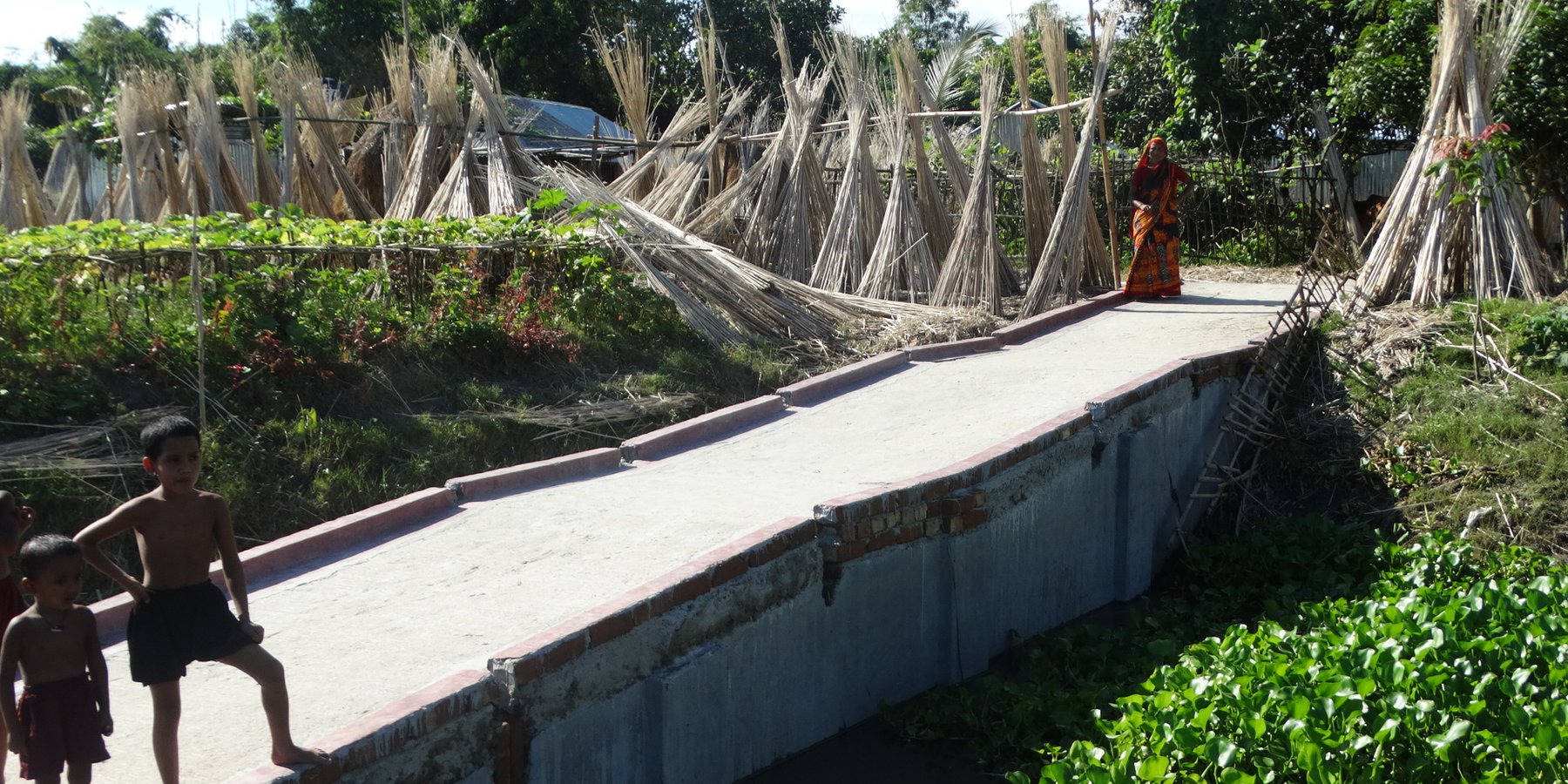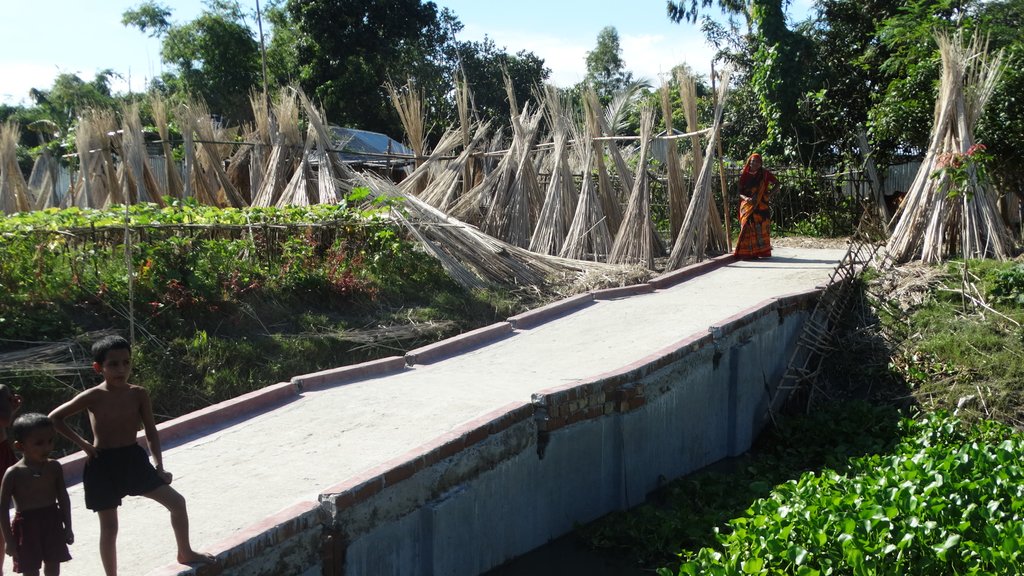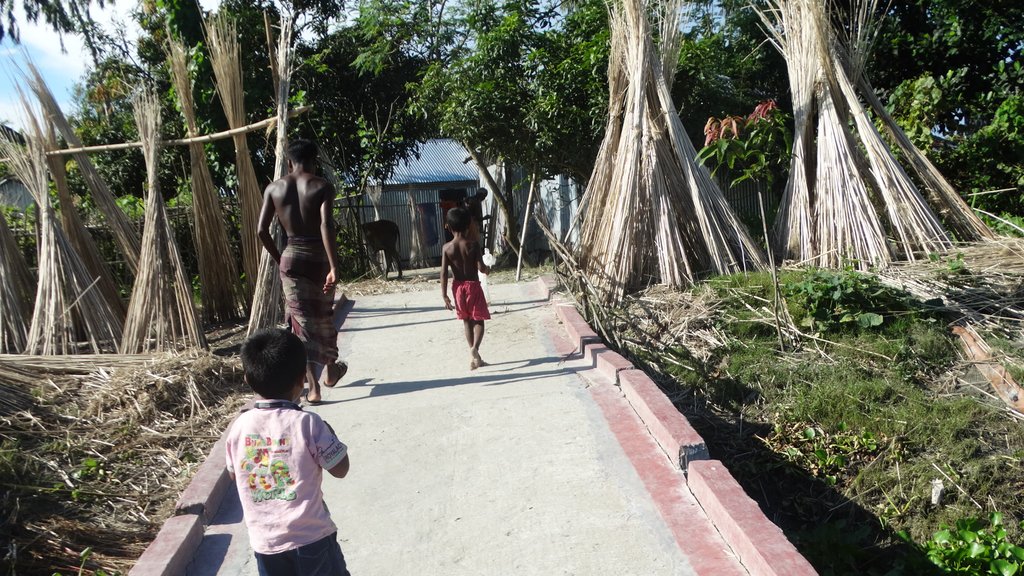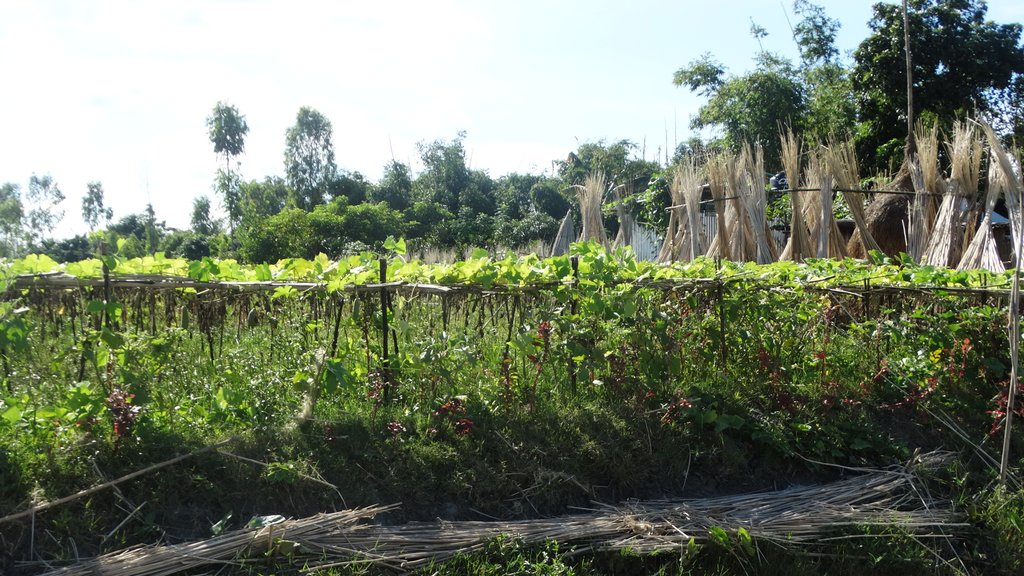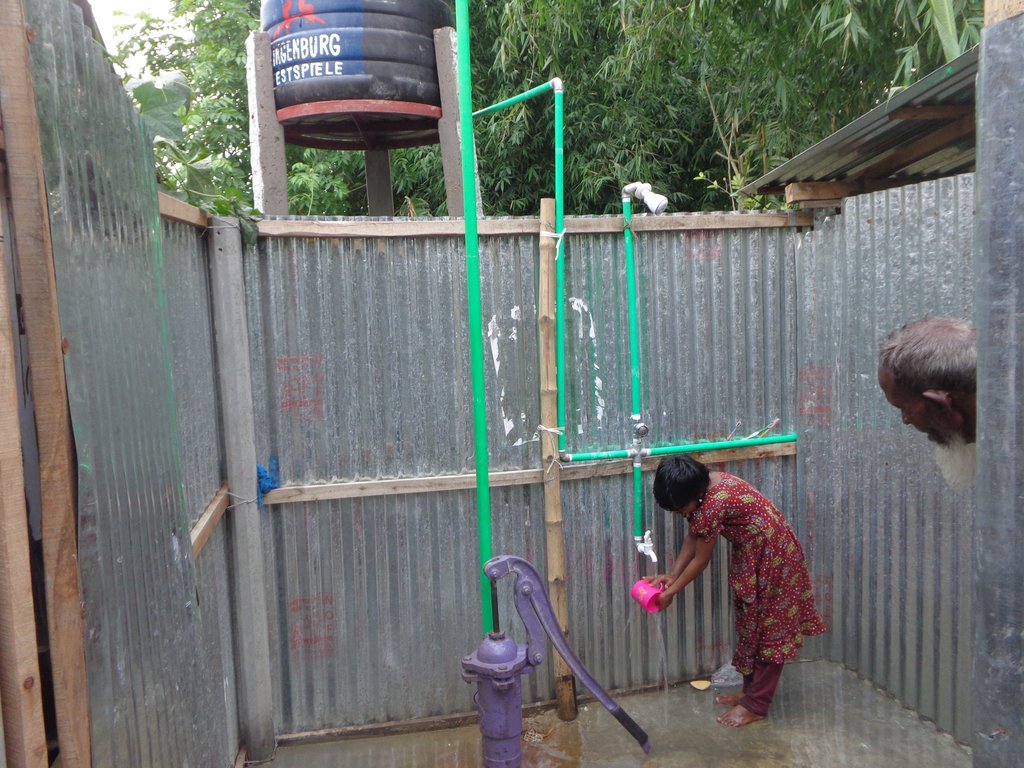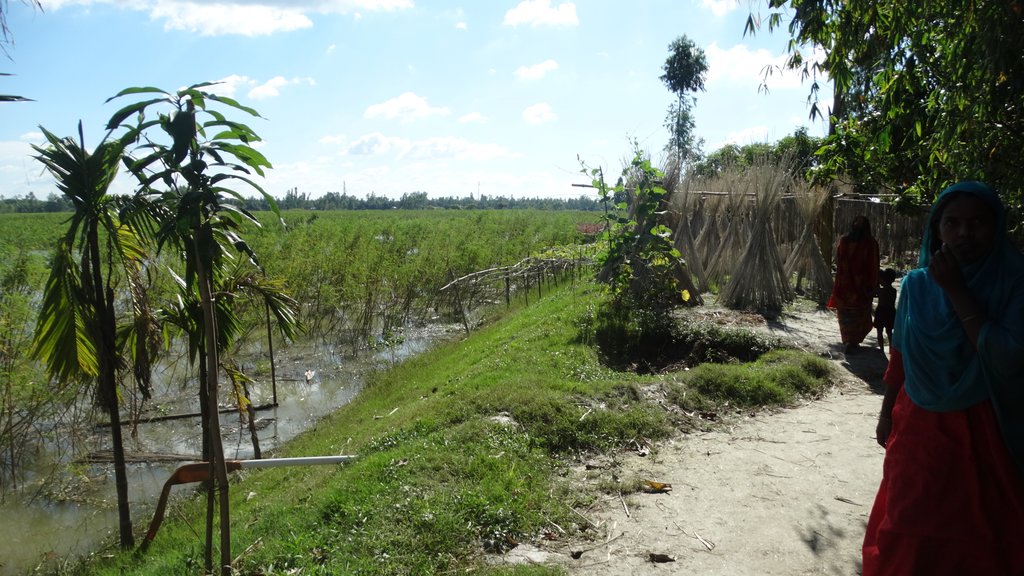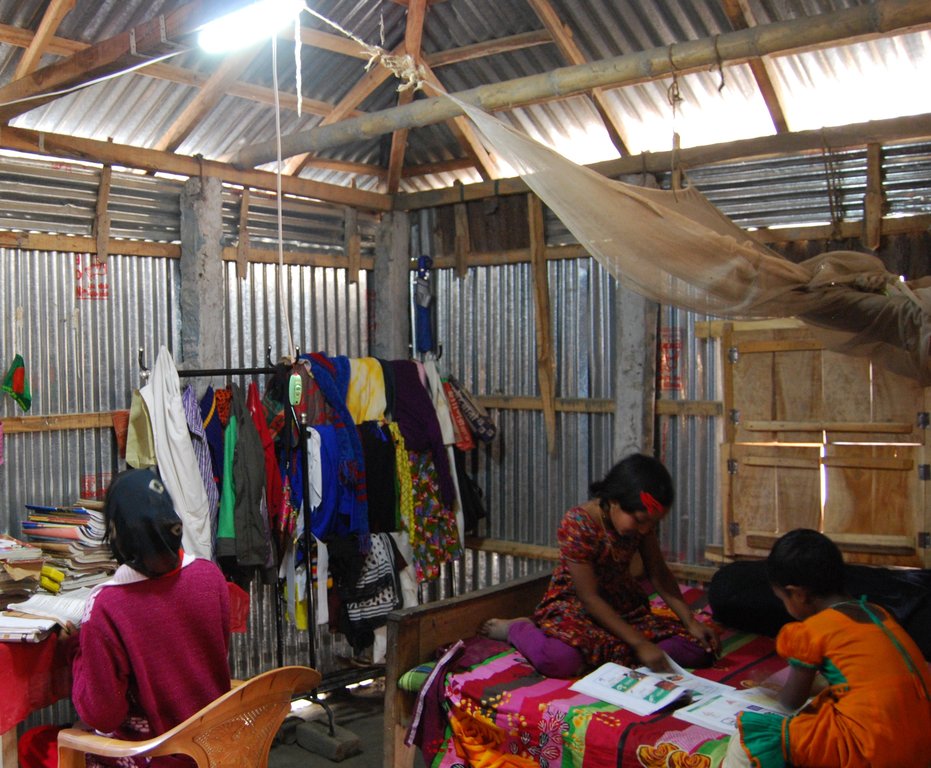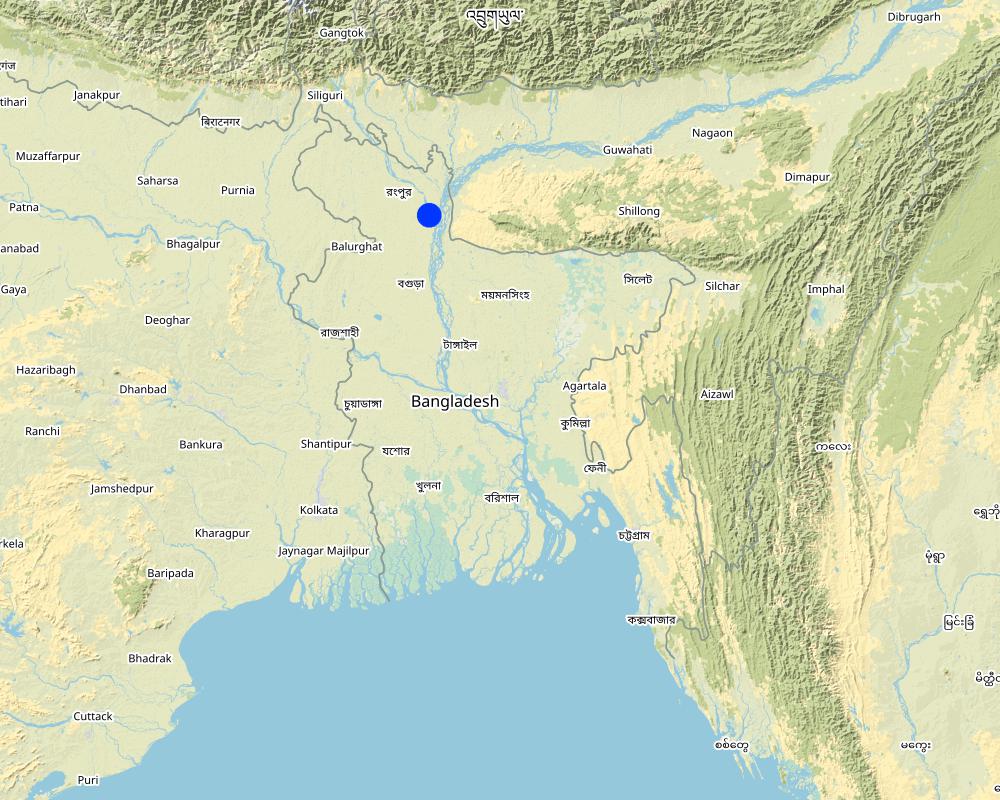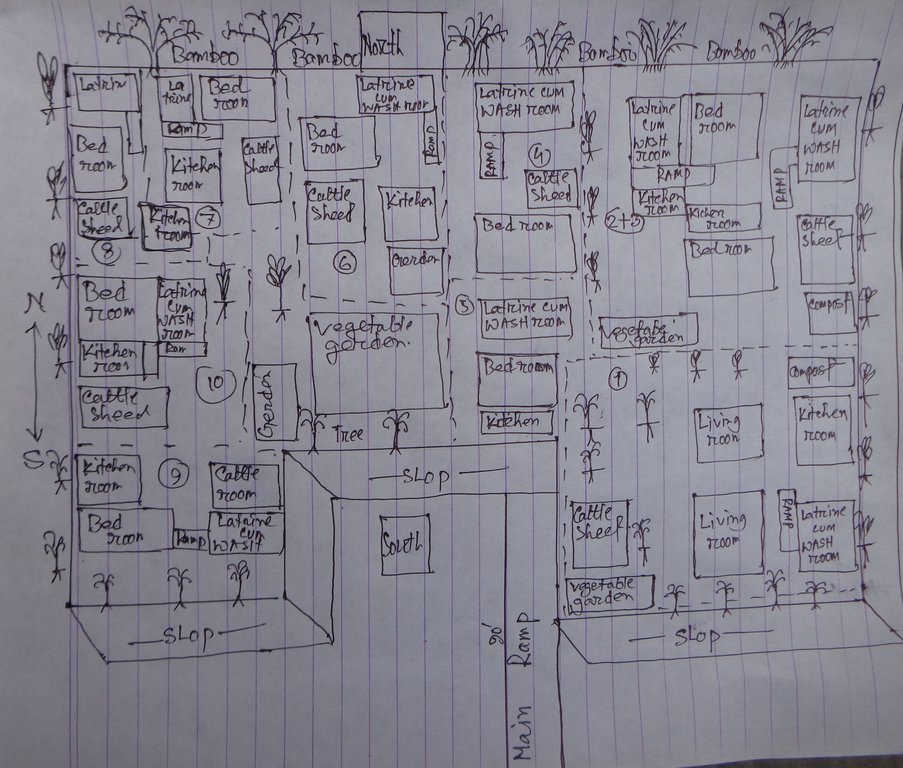Disability inclusive, flood resilient cluster village [ប្រទេសបង់ក្លាដែស]
- ការបង្កើត៖
- បច្ចុប្បន្នភាព
- អ្នកចងក្រង៖ Subir Saha
- អ្នកកែសម្រួល៖ Subir Saha, Manuel Rothe
- អ្នកត្រួតពិនិត្យច្រើនទៀត៖ Alexandra Gavilano, Joana Eichenberger
"Protibandhita Bandhob Bonna Sohisnu Gucca Gram"
technologies_2005 - ប្រទេសបង់ក្លាដែស
ពិនិត្យមើលគ្រប់ផ្នែក
ពង្រីកមើលទាំងអស់ បង្រួមទាំងអស់1. ព័ត៌មានទូទៅ
1.2 ព័ត៌មានលម្អិតពីបុគ្គលសំខាន់ៗ និងស្ថាប័នដែលចូលរួមក្នុងការវាយតម្លៃ និងចងក្រងឯកសារនៃបច្ចេកទេស
ឈ្មោះគម្រោងដែលបានចងក្រងឯកសារ/ វាយតម្លៃលើបច្ចេកទេស (បើទាក់ទង)
Book project: where people and their land are safer - A Compendium of Good Practices in Disaster Risk Reduction (DRR) (where people and their land are safer)ឈ្មោះអង្គភាពមួយ (ច្រើន) ដែលបានចងក្រងឯកសារ/ វាយតម្លៃបច្ចេកទេស (បើទាក់ទង)
Christoffel Blindenmission (CBM) - ប្រទេសស្វ៊ីស1.3 លក្ខខណ្ឌទាក់ទងទៅនឹងការប្រើប្រាស់ទិន្នន័យដែលបានចងក្រងតាមរយៈ វ៉ូខេត
អ្នកចងក្រង និង(បុគ្គលសំខាន់ៗ)យល់ព្រមទទួលយកនូវលក្ខខណ្ឌនានាទាក់ទងទៅនឹងការប្រើប្រាស់ទិន្នន័យដែលបានចងក្រងតាមរយៈវ៉ូខេត:
បាទ/ចា៎
1.4 សេចក្តីប្រកាសស្តីពីចីរភាពនៃការពណ៌នាពីបច្ចេកទេស
តើបច្ចេកទេសដែលបានពណ៌នានេះមានបញ្ហាដែលផ្តោតលើការធ្លាក់ចុះគុណភាពដី, បើដូច្នេះវាមិនអាចត្រូវបានប្រកាសថាជាបច្ចេកទេសនៃការគ្រប់គ្រងប្រកបដោយចីរភាពទេ?
ទេ
មតិយោបល់:
Not problematic with regard land degradation. It provides efficient and sustainable use of available land resources.
1.5 ការយោងទៅលើកម្រងបញ្ជីសំណួរ (មួយ ឬច្រើន) នៃវិធីសាស្ត្រផ្សព្វផ្សាយ SLM (ដែលបានចងក្រងដោយទស្សនៈពិភពលោកស្តីពីវិធីសាស្ត្រ និងបច្ចេកទេសងអភិរក្ស WOCAT)
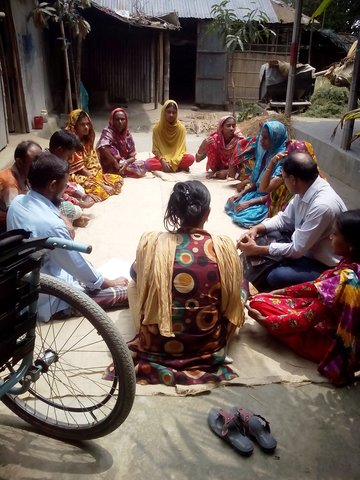
Disability inclusive Disaster Risk Reduction [ប្រទេសបង់ក្លាដែស]
The disability inclusive approach is centered around the meaningful contribution and leadership of persons with disabilties during the entire project management cycle, from the planning stage to the evaluation of the impact of a project. It contributes to empowering them to overcome social exclusion and recognizes their needs and priorities …
- អ្នកចងក្រង៖ Subir Saha
2. ការពណ៌នាពីបច្ចេកទេស SLM
2.1 ការពណ៌នាដោយសង្ខេបពីបច្ចេកទេស
និយមន័យបច្ចេកទេស:
The inclusive, flood-resilient cluster village provides safe housing, food security and income generation for multiple families, including persons with disabilities, in a highly flood prone area of Gaibandha District in northern Bangladesh. The land was raised above flood level and is protected by deep rooted fruit trees to prevent soil erosion and provide income for the land users.
2.2 ការពណ៌នាលម្អិតពីបច្ចេកទេស
ការពណ៌នា:
The inclusive, flood-resilient cluster village was introduced in a rural area with a high risk of recurring monsoon floods. The purpose of the technology is to provide safe housing, safe shelter for livestock, food security and income generation for ten families, including persons with disabilities.
The main components of the technology are:
1) The raising of a piece of land by seven feet (213cm), to three feet (91cm) above expected highest flood levels. Solid soil was banked up to encircle a 30'000 square feet (roughly 50x57m) piece of land and then the space within was filled up with sand collected from a nearby river bank. A one-foot layer of solid soil was added to cover the entire area.
2) The protection of the raised land from soil erosion during floods by planting a combination of deep-rooted fruit- and medicine trees around the border of the raised land. The trees include a number of different types of deep-rooted and light-rooted fruit trees and one type of medicine tree, Azadirachta Indica, locally known as "Neem". In addition, the slope of the border area was covered by grass turf to protect the soil from being washed out by rain. Two types of deep-rooted and flood resistant grasses were used. A drainage system was installed to facilitate water runoff.
3) The planting of a 150 square feet (14m2) commonly used homestead vegetable garden at the center of the cluster village. The cultivated vegetables include red spinach, jute leaf, basella leaf, spinach, radish, cabbage, okra, bottle-guts, cucumber and beans, allowing for a summer and a winter harvest. Together with the fruit trees, the vegetable garden provides food security during prolonged flooding. They also provide improved nutrition and income generating opportunities through selling of a part of the harvest in the market.
4) Making the village accessible for persons with disabilities through different accessibility measures, including the construction of a ramp, connecting the cluster village entrance with the road, and of accessible common Water-, Sanitation- and Hygiene (WASH) facilities, including a latrine, deep bore hole water source and water storage tank.
5) Installation of a solar panel to ensure uninterrupted, flood-resilient power supply. The level of power supply is sufficient to ensure coverage of electricity needs during flood season, when regular supply is around 15% below annual average.
The Cluster village was constructed as part of a disaster risk reduction project by CDD (Center for Disability in Development) from Bangladesh, with the support of CBM (Christoffel Blindenmission), an international development organization and funded by a donor from Germany. The main cost for inputs were provided to the land users by the project, including rent of construction machinery, paid labor, soil and construction material for the ramp and WASH facilities. The land users contributed labor and seedlings for the planning of the border trees and the homestead vegetable garden.
The main benefits of the technology from the perspective of land users are the protection it provides for houses and livestock, which would otherwise be in danger of loss during floods. The availability of food, water and electricity allows land users to remain in their homes during floods and avoid evacuation and the risk associated with it, including for example protection risks or the risk of theft. The flood protected vegetable gardens and fruit trees provide a year-round, sustainable source of food and income, providing food security and improved nutrition. The Neem tree provides medical and hygiene uses of the branches and leaves.
The cluster village is used as a safe space for the land users and other members of the community and their livestock during floods. Land users who are persons with disabilities or elderly benefit from the accessible infrastructure. With multiple families sharing land, the cluster villages provides optimal utilization of land resources. An additional benefit mentioned by land users is that the joint use by multiple families led to a more progressive social culture.
2.3 រូបភាពនៃបច្ចេកទេស
2.5 ប្រទេស/តំបន់/ទីតាំងកន្លែង ដែលបច្ចេកទេសត្រូវបានអនុវត្ត និងបានគ្រប់ដណ្តប់ដោយការវាយតម្លៃនេះ
ប្រទេស:
ប្រទេសបង់ក្លាដែស
តំបន់/រដ្ឋ/ខេត្ត:
Gaibandha District
បញ្ជាក់បន្ថែមពីលក្ខណៈនៃទីតាំង:
Horipur Union, Sundargonj Sub district,
បញ្ជាក់ពីការសាយភាយនៃបច្ចេកទេស:
- អនុវត្តនៅកន្លែងជាក់លាក់មួយ/ ប្រមូលផ្តុំនៅតំបន់តូចៗ
មតិយោបល់:
Kani Charitabari, Horipur Union, Sundargonj sub district, Gaibandha District.
Map
×2.6 កាលបរិច្ឆេទនៃការអនុវត្ត
បង្ហាញឆ្នាំនៃការចុះអនុវត្ត:
2016
2.7 ការណែនាំពីបច្ចេកទេស
សូមបញ្ជាក់តើបច្ចេកទេសត្រូវបានណែនាំឱ្យអនុវត្តដោយរបៀបណា:
- តាមរយៈគម្រោង / អន្តរាគមន៍ពីខាងក្រៅ
មតិយោបល់ (ប្រភេទនៃគម្រោង ។ល។):
The technology was introduced as part of a disaster risk reduction project, implemented the Center for Disability in Development (CDD) with the support of Christoffel Blindemission (CBM) and with participation and leadership of the local community. The project was financially supported a group of donors from Germany.
3. ចំណាត់ថ្នាក់នៃបច្ចេកទេស SLM
3.1 គោលបំណងចម្បង (១ ឬច្រើន) នៃបច្ចេកទេសនេះ
- កាត់បន្ថយហានិភ័យនៃគ្រោះមហន្តរាយ
- បន្ស៊ាំទៅនឹងការប្រែប្រួលអាកាសធាតុ/គ្រោះមហន្តរាយ និងផលប៉ះពាល់របស់វា
- បង្កើតផលប្រយោជន៍សេដ្ឋកិច្ច
- បង្កើតផលប្រយោជន៍សង្គម
3.2 ប្រភេទដីប្រើប្រាស់មួយប្រភេទ (ច្រើនប្រភេទ) ដែលបានអនុវត្តបច្ចេកទេស

លំនៅដ្ឋាន ហេដ្ឋារចនាសម្ព័ន្ធ
- ដីលំនៅស្ថាន អគារ
មតិយោបល់:
Number of growing seasons per year: 2 (Summer and winter)
Livestock density : Livestock are available in every household.
3.4 ការផ្គត់ផ្គង់ទឹក
ការផ្គត់ផ្គង់ទឹកនៅកន្លែងអនុវត្តបច្ចេកទេស:
- ទឹកភ្លៀង និងប្រព័ន្ធស្រោចស្រព
3.5 ក្រុម SLM ដែលបច្ចេកទេសស្ថិតនៅក្នុង
- ធ្វើឱ្យប្រសើរឡើងគម្របដី/ ដំណាំគម្របដី
- វិធានការអនុវត្តកាត់ទទឹងទីជម្រាល
- គេហសួន
3.6 វិធានការ SLM ដែលបញ្ចូលនូវបច្ចេកទេស

វិធានការរុក្ខជាតិ
- V1: ឈើធំៗ និងដើមឈើតូចៗ
- V2: ស្មៅនិងរុក្ខជាតិៗដែលដុះមានអាយុមិនលើសពី 2ឆ្នាំ

វិធានការរចនាស័ម្ពន្ធ
- S7: ការប្រមូលទឹកស្តុកទុក/ផ្គត់ផ្គង់ទឹក/ សម្ភារៈស្រោចស្រព
- S8: អនាម័យ/ទំនប់ទឹកកង្វក់
- S9: រោងដំណាំ និងរោងចិញ្ចឹមសត្វ
- S10: វិធានការសន្សំថាមពល

វិធានការគ្រប់គ្រង
- M1: ការផ្លាស់ប្តូរប្រភេទដីប្រើប្រាស់
- M2: ការផ្លាស់ប្តូរការគ្រប់គ្រង/ កម្រិតអាំងតង់ស៊ីតេ
- M6: ការគ្រប់គ្រងសំណល់ (កែឆ្នៃទ្បើងវិញ ប្រើប្រាស់ឡើងវិញ ឬបន្ថយការប្រើប្រាស់)
3.7 កំណត់ប្រភេទនៃការធ្លាក់ចុះគុណភាពដីសំខាន់ៗដែលបច្ចេកទេសនេះបានដោះស្រាយ

ការហូរច្រោះដីដោយសារទឹក
- Wt: ការបាត់ដីស្រទាប់លើដោយការហូរច្រោះ
- Wr: សំណឹកដីច្រាំងទន្លេ
3.8 ការពារ កាត់បន្ថយ ឬស្តារឡើងវិញនៃការធ្លាក់ចុះគុណភាពដី
បញ្ជាក់ពីគោលដៅរបស់បច្ចេកទេស ដែលផ្តោតទៅការធ្លាក់ចុះគុណភាពដី:
- ការការពារការធ្លាក់ចុះគុណភាពដី
- ការកាត់បន្ថយការធ្លាក់ចុះគុណភាពដី
4. បច្ចេកទេសជាក់លាក់ សកម្មភាពអនុវត្ត ធាតុចូល និងថ្លៃដើម
4.1 គំនូសបច្ចេកទេសនៃបច្ចេកទេសនេះ
លក្ខណៈពិសេសនៃបច្ចេកទេស (ទាក់ទងនឺងគំនូរបច្ចេកទេស):
The drawing shows the layout of the disability inclusive, flood resilient Cluster village. The components of the technology are:
Raised land/plinth: 1) Purchase of land of a total area of 18'000 square feet (ca. 40x40m). Land ownership transferred to joint ownership of 10 families. 2) Collect 15'000 cubic feet (425m3) of solid soil from different pieces of land in the community. The soil was donated by members of the community, who were either related to the land users of the cluster village or donated in support of the construction of a safe space which can be used by the community during floods. 3) Banking up of 3 feet (91cm) of solid soil along the borders of the land. 4) Filling of area with 140'000 cubic feet (3965m3) of sand, extracted from a nearby riverbank with a rented sand extraction machine, raising the land to 6 feet (183cm). 5) Covering the entire area with one additional foot of solid soil, rasing the land to 7 feet (213cm), which means 3 feet (91cm) above the maximum expected flood levels.
Soil protected through deep-rooted trees: 1) Planting of deep-rooted and light-rooted fruit trees, surrounding the entire border of the raised land. The trees include deep rooted fruit trees like mango, black berry, jack-fruit, guava, coconut and areca nut, light-rooted fruit trees like banana and Papaya, a deep-rooted medicine tree, locally called "Neem" and the light-rooted Dhol Kalmi tree (pink morning glory). The number of deep-rooted threes was 100, with a spacing of around 5 feet in between each. They were planted to cover the entire perimeter of the raised land. In between the deep-rooted trees, 60 light-rooted trees were planted. In front of the deep-rooted trees, 60 bamboo bushes were planted to provide additional protection from wind and rain. 2) Turfing of the entire slope surrounding the cluster village with two flood resistant grasses: Durva (Cynodon dactylon) and Catkin grass. 3) Installation of a central drainage system with 15 plastic pipes ensuring water runoff from the wastewater pond.
Road access through ramp: The connecting ramp of the cluster village is 90 feet length, 6 feet width. There are five landing point of this ramp with smooth slopping. The construction material includes class one brick, brick stone, cement, sand, polythene and red oxide color for color contrast, which is appropriate for low vision and visually impaired persons. There is a 5 inch border on both sides of the ramp for safe movement of a wheel chair user.
Accessible household water and sanitation facilities: Latrine and wash-room are constructed for every house in the cluster village, following universal design standards. Latrines are connected to the wash room and the main house through ramps. There is a railing on both sides of the latrine and the entrance is wider for access of a wheel chair users. Water system for the latrine and wash room is provided from a water tank on three pillars behind the latrine, which is also connected to the main house for provision of drinking water. The tank is filled by hand pump ('magic pump') which functions with minimal hand pressure. The WASH facilities are accessible and usable by everyone including persons with disabilities, pregnant women or aged persons.
Home vegetable gardens: Every household has an individual homestead vegetable gardens where land users cultivate seasonal vegetables year-round. Gardens vary in size between averaging about 1.5 decimal (60m2) in size and are surrounded by bamboo fencing. The land owners are using organic fertilizer/compost for the vegetable production of their choice. By using cow's manure and wastage they are producing the compost in the behind of their houses in a ditch.
Solar system: A mini solar system is installed on the roof for each house by using a small panel with a 12-volt battery . Each system has the capacity of providing power for light for 8 hours. An introduction to system maintenance was given to the land users by the provider of the solar system.
ឈ្មោះអ្នកនិពន្ធ:
Shahidul Islam
កាលបរិច្ឆេទ:
09/11/2016
4.2 ព័ត៌មានទូទៅដែលពាក់ព័ន្ធនឹងការគណនាធាតុចូល និងថ្លៃដើម
កំណត់របៀបនៃការគណនាថ្លៃដើម និងធាតុចូល:
- ក្នុងឯកតាបច្ចេកទេស
បញ្ជាក់ឯកតា:
Cluster village
បញ្ជាក់ពីទំហំនៃឯកតា (បើពាក់ព័ន្ធ):
18'000 square feet piece of land
ផ្សេងៗ/ រូបិយប័ណ្ណជាតិ (បញ្ជាក់):
Bangladeshi Taka
បើពាក់ព័ន្ធសូមកំណត់អត្រាប្តូរប្រាក់ពីដុល្លាទៅរូបិយប័ណ្ណតំបន់ (ឧ. 1 ដុល្លារ = 79.9 រៀលនៃរូបិយប័ណ្ណប្រេស៊ីល) ៖ 1 ដុល្លារ =:
80,0
កំណត់ថ្លៃឈ្នួលជាមធ្យមនៃការជួលកម្លាំងពលកម្មក្នុងមួយថ្ងៃ:
300
4.3 សកម្មភាពបង្កើត
| សកម្មភាព | រយៈពេល (រដូវកាល) | |
|---|---|---|
| 1. | Selecting the place for cluster village construction | During rainy season in 2015 |
| 2. | Establish collaboration with 10 families who will become land users | December 2015 |
| 3. | Land Raising & Ramp construction | December 2015 to March 2016 |
| 4. | Reconstruction the existing houses of the land users on the raised land | April 2016, before onset of rainy season 2016 |
| 5. | Planting of deep- and light-rooted fruits trees, bamboo bushes and grass turfing along the boundery | February 2016 to March 2016 |
| 6. | Install accessible water & sanitation system | April-June 2016 |
| 7. | Establish home garden in front of each house | June-July 2016 |
| 8. | Install mini solar system for each house | Aug-sep 2016 |
| 9. | Prepare livestock shed for each house | October 2016 |
4.4 ថ្លៃដើម និងធាតុចូលដែលត្រូវការសម្រាប់ការបង្កើតបច្ចេកទេស
| បញ្ជាក់ពីធាតុចូល | ឯកតា | បរិមាណ | ថ្លៃដើមក្នុងមួយឯកតា | ថ្លៃធាតុចូលសរុប | % នៃថ្លៃដើមដែលចំណាយដោយអ្នកប្រើប្រាស់ដី | |
|---|---|---|---|---|---|---|
| កម្លាំងពលកម្ម | Land raising, tree planting and turfing on slope | person days | 290,0 | 300,0 | 87000,0 | 10,0 |
| កម្លាំងពលកម្ម | Ramp construction | person days | 115,0 | 350,0 | 40250,0 | 10,0 |
| កម្លាំងពលកម្ម | House reconstruction and WASH facilities | person days | 200,0 | 400,0 | 80000,0 | 10,0 |
| កម្លាំងពលកម្ម | Solar system installation | person days | 10,0 | 300,0 | 3000,0 | 10,0 |
| សម្ភារៈ | WASH equipment (latrine, magic pump, water tank, pipes, switch, pillars and other) | pieces | 10,0 | 46658,0 | 466580,0 | |
| សម្ភារៈ | Solar system | pieces | 10,0 | 6300,0 | 63000,0 | |
| សម្ភារៈដាំដុះ | Deep rooted trees | pieces | 100,0 | 40,0 | 4000,0 | 100,0 |
| សម្ភារៈដាំដុះ | Seed for vegetable | KG | 5,0 | 1000,0 | 5000,0 | 100,0 |
| សម្ភារៈដាំដុះ | Sapling purchase | pieces | 100,0 | 50,0 | 5000,0 | 100,0 |
| សម្ភារៈដាំដុះ | Light rooted tree | pieces | 60,0 | 30,0 | 1800,0 | |
| ជី និងសារធាតុពុល | Organic fertilizer (compost) | KG | 600,0 | 10,0 | 6000,0 | 100,0 |
| សម្ភារៈសាងសង់ | Rent for shallow machine for sand extraction | Daily rent | 10,0 | 28800,0 | 288000,0 | |
| សម្ភារៈសាងសង់ | Grass turfing | square feet | 15000,0 | 10,0 | 150000,0 | |
| សម្ភារៈសាងសង់ | Allowance for house reconstruction material | House | 10,0 | 2000,0 | 20000,0 | |
| សម្ភារៈសាងសង់ | Ramp construction | Piece | 1,0 | 125750,0 | 125750,0 | |
| ផ្សេងៗ | Project management (monitoring and support) | persons-days | 180,0 | 2400,0 | 432000,0 | |
| ថ្លៃដើមសរុបក្នុងការបង្កើតបច្ចេកទេស | 1777380,0 | |||||
| ថ្លៃដើមសរុបក្នុងការបង្កើតបច្ចេកទេសគិតជាដុល្លារ | 22217,25 | |||||
ប្រសិនបើអ្នកប្រើប្រាស់ដីមិនមានថ្លៃដើម 100% សូមបញ្ជាក់ថានរណាដែលចំណាយថ្លៃដើមដែលនៅសល់:
The project, human resource supported by CBM, CDD and a funded by private donor.
មតិយោបល់:
Labor for tree plantation, home stead gardening & house reconstruction was contributed by the land users.
4.5 សកម្មភាពថែទាំ
| សកម្មភាព | ពេលវេលា/ ភាពញឹកញាប់ | |
|---|---|---|
| 1. | Turfing: Repair leakages, replace grass etc. | before onset of rains |
| 2. | Tree maintenance: Cutting branches, manure of roots etc. | Rainy season |
| 3. | Vegetable gardening | Summer & Winter season |
| 4. | Housing repairs | After harvesting season/ once in a year |
| 5. | Water and Sanitation system servicing and repairs | After harvesting season/once in a year |
| 6. | Solar system maintenance | Winter season/once in ayear |
| 7. | Village group meeting for decision making and conflict resolution | Once in a month |
| 8. | Organic composting/fertilizer production | Continuous |
4.6 កំណត់ថ្លៃដើមសម្រាប់ការថែទាំ/ សកម្មភាពរបស់បច្ចេកទេស (ក្នុងរយៈពេលមួយឆ្នាំ)
| បញ្ជាក់ពីធាតុចូល | ឯកតា | បរិមាណ | ថ្លៃដើមក្នុងមួយឯកតា | ថ្លៃធាតុចូលសរុប | % នៃថ្លៃដើមដែលចំណាយដោយអ្នកប្រើប្រាស់ដី | |
|---|---|---|---|---|---|---|
| កម្លាំងពលកម្ម | House repairs | person days | 10,0 | 300,0 | 3000,0 | 100,0 |
| កម្លាំងពលកម្ម | Ramp repairs | person days | 10,0 | 300,0 | 3000,0 | 100,0 |
| កម្លាំងពលកម្ម | Plingth raising and plantation | person days | 30,0 | 300,0 | 9000,0 | 100,0 |
| កម្លាំងពលកម្ម | Solar system servicing by technical experts | piece | 10,0 | 500,0 | 5000,0 | 100,0 |
| សម្ភារៈដាំដុះ | Seed for vegetable gardening | KG | 5,0 | 1000,0 | 5000,0 | |
| សម្ភារៈសាងសង់ | Soil for slope maintenance | square feet | 5000,0 | 10,0 | 50000,0 | |
| សម្ភារៈសាងសង់ | Sand for slope maintenance | KG | 5000,0 | 2,0 | 10000,0 | |
| ថ្លៃដើមសរុបសម្រាប់ការថែទាំដំណាំតាមបច្ចេកទេស | 85000,0 | |||||
| ថ្លៃដើមសរុបសម្រាប់ការថែទាំដំណាំតាមបច្ចេកទេសគិតជាដុល្លារ | 1062,5 | |||||
មតិយោបល់:
Land users are agreed to contribute 100% maintenance cost
4.7 កត្តាសំខាន់បំផុតដែលមានឥទ្ធិពលដល់ការចំណាយ
ពណ៌នាពីកត្តាប៉ះពាល់ចម្បងៗទៅលើថ្លៃដើម:
Market fluctuation and scarcity of goods in the flood season.
5. លក្ខណៈបរិស្ថានធម្មជាតិ និងមនុស្ស
5.1 អាកាសធាតុ
បរិមាណទឹកភ្លៀងប្រចាំឆ្នាំ
- < 250 មម
- 251-500 មម
- 501-750 មម
- 751-1,000 មម
- 1,001-1,500 មម
- 1,501-2,000 មម
- 2,001-3,000 មម
- 3,001-4,000 មម
- > 4,000 មម
លក្ខណៈពិសេស/ មតិយោបល់លើរដូវភ្លៀង:
Heavy rainfalls are one of the causes for flooding
តំបន់កសិអាកាសធាតុ
- សើម
5.2 សណ្ឋានដី
ជម្រាលជាមធ្យម:
- រាបស្មើ (0-2%)
- ជម្រាលតិចតួច (3-5%)
- មធ្យម (6-10%)
- ជម្រាលខ្ពស់បន្តិច (11-15%)
- ទីទួល (16-30%)
- ទីទួលចោត (31-60%)
- ទីទួលចោតខ្លាំង (>60%)
ទម្រង់ដី:
- ខ្ពង់រាប
- កំពូលភ្នំ
- ជម្រាលភ្នំ
- ជម្រាលទួល
- ជម្រាលជើងភ្នំ
- បាតជ្រលងភ្នំ
តំបន់តាមរយៈកម្ពស់ :
- 0-100 ម
- 101-500 ម
- 501-1,000 ម
- 1,001-1,500 ម
- 1,501-2,000 ម
- 2,001-2,500 ម
- 2,501-3,000 ម
- 3,001-4,000 ម
- > 4,000 ម
បញ្ជាក់ថាតើបច្ចេកទេសនេះត្រូវបានអនុវត្តន៍នៅក្នុង:
- មិនពាក់ព័ន្ធទាំងអស់
5.3 ដី
ជម្រៅដីជាមធ្យម:
- រាក់ខ្លាំង (0-20 សម)
- រាក់ (21-50 សម)
- មធ្យម (51-80 សម)
- ជ្រៅ (81-120 សម)
- ជ្រៅខ្លាំង (> 120 សម)
វាយនភាពដី (> 20 សម ស្រទាប់ក្នុង):
- គ្រើម/ មានពន្លឺ (ខ្សាច់)
សារធាតុសរីរាង្គនៅស្រទាប់ដីខាងលើ:
- ខ្ពស់ (>3%)
5.4 ទឹកដែលអាចទាញមកប្រើប្រាស់បាន និងគុណភាពទឹក
នីវ៉ូទឹកក្រោមដី:
> 50 ម
ទឹកលើដីដែលអាចទាញយកប្រើប្រាស់បាន:
កម្រិតមធ្យម
គុណភាពទឹក (មិនបានធ្វើប្រត្តិកម្ម):
ទឹកពិសារដែលមានគុណភាពល្អ
តើមានបញ្ហាភាពទឹកប្រៃហូរចូលមកដែរឬទេ?
ទេ
តើទឹកជំនន់កំពុងកើតមាននៅតំបន់នេះដែររឺទេ?
បាទ/ចា៎
ភាពទៀងទាត់:
ញឹកញាប់
5.5 ជីវៈចម្រុះ
ភាពសម្បូរបែបនៃប្រភេទ:
- ទាប
ភាពសម្បូរបែបនៃទីជម្រក:
- ទាប
5.6 លក្ខណៈនៃអ្នកប្រើប្រាស់ដីដែលអនុវត្តបច្ចេកទេស
នៅមួយកន្លែង ឬពនេចរ :
- នៅមួយកន្លែង
ទីផ្សារនៃប្រព័ន្ធផលិតកម្ម:
- ពាក់កណ្តាលពាណិជ្ជកម្ម (ផ្គត់ផ្គង់ខ្លួនឯង/ ពាណិជ្ជកម្ម)
ចំណូលក្រៅកសិកម្ម:
- ច្រើនជាង 50% នៃចំណូល
កម្រិតជីវភាព:
- មិនល្អ
ឯកជន ឬក្រុម:
- ធ្វើខ្លួនឯង/ គ្រួសារ
- ជាក្រុម/ សហគមន៍
កម្រិតប្រើប្រាស់គ្រឿងយន្ត:
- ប្រើកម្លាំងពលកម្ម
- ប្រើកម្លាំងសត្វ
យេនឌ័រ:
- ស្ត្រី
- បុរស
អាយុរបស់អ្នកប្រើប្រាស់ដី:
- យុវវ័យ
- វ័យកណ្តាល
សូមបញ្ជាក់ពីលក្ខណៈពាក់ព័ន្ធផ្សេងទៀតអំពីអ្នកប្រើប្រាស់ដី:
Age of land users includes children, youth, middle-aged as well as elderly.
5.7 ទំហំផ្ទៃដីជាមធ្យមនៃដីប្រើប្រាស់ដោយអ្នកប្រើប្រាស់ដី ក្នុងការអនុវត្តបច្ចេកទេស
- < 0.5 ហិកតា
- 0.5-1 ហិកតា
- 1-2 ហិកតា
- 2-5 ហិកតា
- 5-15 ហិកតា
- 15-50 ហិកតា
- 50-100 ហិកតា
- 100-500 ហិកតា
- 500-1,000 ហិកតា
- 1,000-10,000 ហិកតា
- > 10,000 ហិកតា
តើផ្ទៃដីនេះចាត់ទុកជាទំហំកម្រិតណាដែរ ខ្នាតតូច មធ្យម ឬខ្នាតធំ (ធៀបនឹងបរិបទតំបន់)?
- ខ្នាតតូច
មតិយោបល់:
Land users jointly own the land of the cluster village. They do not own any additional agricultural land and work as daily laborers and sharecropers.
5.8 ភាពជាម្ចាស់ដី កម្មសិទ្ធប្រើប្រាស់ដី និងកម្មសិទ្ធប្រើប្រាស់ទឹក
ភាពជាម្ចាស់ដី:
- ក្រុម
កម្មសិទ្ធិប្រើប្រាស់ដី:
- ឯកជន
កម្មសិទ្ធប្រើប្រាស់ទឹក:
- ឯកជន
មតិយោបល់:
Land users own the land of the cluster village jointly, including a proportional share of land- and water use rights.
5.9 ការប្រើប្រាស់សេវាកម្ម និងហេដ្ឋារចនាសម្ព័ន្ធ
សុខភាព:
- មិនល្អ
- មធ្យម
- ល្អ
ការអប់រំ:
- មិនល្អ
- មធ្យម
- ល្អ
ជំនួយបច្ចេកទេស:
- មិនល្អ
- មធ្យម
- ល្អ
ការងារ (ឧ. ការងារក្រៅកសិដ្ឋាន):
- មិនល្អ
- មធ្យម
- ល្អ
ទីផ្សារ:
- មិនល្អ
- មធ្យម
- ល្អ
ថាមពល:
- មិនល្អ
- មធ្យម
- ល្អ
ផ្លូវ និងការដឹកជញ្ជូន:
- មិនល្អ
- មធ្យម
- ល្អ
ទឹកផឹក និងអនាម័យ:
- មិនល្អ
- មធ្យម
- ល្អ
សេវាកម្មហិរញ្ញវត្ថុ:
- មិនល្អ
- មធ្យម
- ល្អ
6. ផលប៉ះពាល់ និងការសន្និដ្ឋាន
6.1 ផលប៉ះពាល់ក្នុងបរិវេណអនុវត្តបច្ចេកទេសដែលកើតមាន
ផលប៉ះពាល់លើសេដ្ឋកិច្ចសង្គម
ផលិតផល
ផលិតកម្មដំណាំ
មតិយោបល់/ ការបញ្ជាក់:
Fruit and vegetable production increased after introduction of the cluster village. Because of decreased loss of home and property during floods, labor is freed for crop production which increased overall crop production in the wider area.
គុណភាពដំណាំ
មតិយោបល់/ ការបញ្ជាក់:
Fruit and vegetable quality is improved because of availability of Irrigation.
ផលិតកម្មសត្វ
មតិយោបល់/ ការបញ្ជាក់:
Livestock mortality rate is reduced because of safe space in Cluster village.
ហានិភ័យនៃភាពបរាជ័យរបស់ផលិតកម្ម
មតិយោបល់/ ការបញ្ជាក់:
Homestead vegetable garden and fruit tree plantation above flood level has a significantly reduced risk of production failure.
ភាពសម្បូរបែបនៃផលិតផល
មតិយោបល់/ ការបញ្ជាក់:
The flood-protected homestead vegetable garden allows for higher product diversity.
ផ្ទៃដីផលិតកម្ម
មតិយោបល់/ ការបញ្ជាក់:
Increased availabilty of flood protected land for vegetable gardening.
ការបង្កើតថាមពល
មតិយោបល់/ ការបញ្ជាក់:
Energy supply was not available before installation of solar panel.
ទឹកដែលអាចទាញមកប្រើប្រាស់បាន និងគុណភាពទឹក
ទឹកបរិភោគដែលអាចទាញយកមកប្រើប្រាស់បាន
មតិយោបល់/ ការបញ្ជាក់:
Installation of deep tube well water source.
គុណភាពទឹកបរិភោគ
មតិយោបល់/ ការបញ្ជាក់:
Significantly higher water quality during flood, because of flood protected water source in cluster village.
ទឹកដែលអាចប្រើប្រាស់បានសម្រាប់ការចិញ្ចឹមសត្វ
មតិយោបល់/ ការបញ្ជាក់:
Installation of deep tube well water source.
គុណភាពទឹកសម្រាប់ការចិញ្ចឹមសត្វ
មតិយោបល់/ ការបញ្ជាក់:
Significantly higher water quality during flood, because of flood protected water source in cluster village.
ទឹកប្រើប្រាស់សម្រាប់ស្រោចស្រព
មតិយោបល់/ ការបញ្ជាក់:
Irrigation available to land users after installation of deep tube well.
តម្រូវការទឹកសម្រាប់ស្រោចស្រព
មតិយោបល់/ ការបញ្ជាក់:
Demand for irrigation water increased because of vegetable garden.
ចំណូល និងថ្លៃដើម
ចំណូលក្នុងកសិដ្ឋាន
មតិយោបល់/ ការបញ្ជាក់:
Increase of farm income through selling of fruit and vegetables.
ភាពសម្បូរបែបប្រភពប្រាក់ចំណូល
មតិយោបល់/ ការបញ្ជាក់:
Additional income source through selling of fruit and vegetables.
ភាពខុសគ្នាផ្នែកសេដ្ឋកិច្ច
មតិយោបល់/ ការបញ្ជាក់:
Decreased income disparities between the land users of the cluster village due to fruit and vegetable production available to all land users, Decrease income disparities between land users of the cluster village and other members of the communty because of the reduction of loss from flood damage.
បន្ទុកការងារ
មតិយោបល់/ ការបញ្ជាក់:
Somewhat increased workload for maintenance of technology but decreased because of avoidance of damaged from floods.
ផលប៉ះពាល់ទៅលើវប្បធម៌សង្គម
សន្តិសុខស្បៀង/ ភាពគ្រប់គ្រាន់ខ្លួនឯង
មតិយោបល់/ ការបញ្ជាក់:
Increased food security through flood prodected homestead garden and tree plantation.
ស្ថានភាពសុខភាព
មតិយោបល់/ ការបញ្ជាក់:
Higher attendance of health workers because the cluster village offer suitable group meeting rooms and accomodation. Cluster village was constructed in vicinity of community clinic. Better hygiene through WASH facilities.
ឱកាសវប្បធម៍
មតិយោបល់/ ការបញ្ជាក់:
The cluster village is a suitable meeting point for the entire community, for social gatherings or festivals.
ឱកាសនៃការបង្កើតថ្មី
មតិយោបល់/ ការបញ្ជាក់:
Cluster village offers common space for children and other land users for Joint recreational activities.
ស្ថានភាពក្រុមដែលមានបញ្ហាក្នុងសង្គម និងសេដ្ឋកិច្ច
មតិយោបល់/ ការបញ្ជាក់:
Much improved situation for persons with disabiltiies who are part of the land users. All persons with disabiltiies in the wider community use the cluster village as a safe space during floods. Improved situation for all land users who are from marginalized parts of society (daily laborers and share croppers).
ផលប៉ះពាល់ទៅលើអេកូឡូស៊ី
ដី
ការបាត់បង់ដី
មតិយោបល់/ ការបញ្ជាក់:
Soil erosion during floods decreased because of deep- and light-rooted border tree plantation.
ការកាត់បន្ថយហានិភ័យនៃគ្រោះមហន្តរាយ និងគ្រោះអាកាសធាតុ
ផលប៉ះពាល់នៃទឹកជំនន់
មតិយោបល់/ ការបញ្ជាក់:
Raised land as safe space above flood level.
ផលប៉ះពាល់នៃគ្រោះរាំងស្ងួត
មតិយោបល់/ ការបញ្ជាក់:
Drought impact in summer season decreased because of Irrigation.
6.2 ផលប៉ះពាល់ក្រៅបរិវេណអនុវត្តបច្ចេកទេសដែលកើតមាន
available shelter and safe space
មតិយោបល់/ ការបញ្ជាក់:
Cluster village provides additional safe space/shelter for the wider community.
6.3 ភាពប្រឈម និងភាពរួសនៃបច្ចេកទេសទៅនឹងការប្រែប្រួលអាកាសធាតុ និងគ្រោះអាកាសធាតុ/ គ្រោះមហន្តរាយ (ដែលដឹងដោយអ្នកប្រើប្រាស់ដី)
គ្រោះអាកាសធាតុ (មហន្តរាយ)
គ្រោះមហន្តរាយអាកាសធាតុ
| លក្ខណៈឆ្លើយតបនៃបច្ចេកទេសទៅនឹងការប្រែប្រួលអាកាសធាតុ | |
|---|---|
| រាំងស្ងួត | ល្អ |
គ្រោះមហន្តរាយទឹក
| លក្ខណៈឆ្លើយតបនៃបច្ចេកទេសទៅនឹងការប្រែប្រួលអាកាសធាតុ | |
|---|---|
| ទឹកជំនន់ទូទៅ (ទន្លេ) | ល្អណាស់ |
6.4 ការវិភាគថ្លៃដើម និងអត្ថប្រយោជន៍
តើផលចំណេញ និងថ្លៃដើមត្រូវបានប្រៀបធៀបគ្នាយ៉ាងដូចម្តេច (ទស្សនៈរបស់អ្នកប្រើប្រាស់ដី)?
រយៈពេលខ្លី:
វិជ្ជមាន
រយៈពេលវែង:
វិជ្ជមានខ្លាំង
តើផលចំណេញ និងការថែទាំ/ ជួសជុលត្រូវបានប្រៀបធៀបគ្នាយ៉ាងដូចម្តេច (ទស្សនៈរបស់អ្នកប្រើប្រាស់ដី)?
រយៈពេលខ្លី:
វិជ្ជមានតិចតួច
រយៈពេលវែង:
វិជ្ជមានខ្លាំង
6.5 ការទទួលយកបច្ចេកទេស
- 11-50%
បើអាច សូមបញ្ជាក់ពីបរិមាណ (ចំនួនគ្រួសារ និង/ ឬតំបន់គ្របដណ្តប់):
Around 10-15% of households which equals roughly 70 households.
ក្នុងចំណោមគ្រួសារទាំងអស់ដែលបានអនុវត្តបច្ចេកទេស តើមានប៉ុន្មានគ្រួសារដែលចង់ធ្វើដោយខ្លួនឯង ដោយមិនទទួលបានសម្ភារៈលើកទឹកចិត្ត/ប្រាក់ឧបត្ថម្ភ?:
- 0-10%
មតិយោបល់:
The technology is replicated by households who receive assistance from local government for families at risk of flood damage.
6.6 ការបន្សុំា
តើថ្មីៗនេះ បច្ចេកទេសនេះត្រូវបានកែតម្រូវដើម្បីបន្ស៊ាំទៅនឹងស្ថានភាពប្រែប្រួលដែរឬទេ?
បាទ/ចា៎
បើឆ្លើយបាទ/ ចា៎ សូមកំណត់ថាតើស្ថានភាពប្រែប្រួលមួយណាត្រូវបានបន្ស៊ាំ:
- បម្រែបម្រួលទីផ្សារ
បញ្ជាក់ពីការបន្ស៊ាំនៃបច្ចេកទេស (ការរៀបចំ, ឧបករណ៍/ប្រភេទ ។ល។):
Peoples of cluster villages are selling vegetables and fruits in the local market and some of them are carrying the fruits in the distance market. They are becoming more interested to plant more fruit trees in the cluster village. If it is continue in future it would be a fruits and vegetable market in the cluster village. At the same time they started selling cows milk in the local market and its demand is increasing day to day.
6.7 ភាពខ្លាំង/ គុណសម្បត្តិ/ ឱកាសនៃបច្ចេកទេស
| ភាពខ្លាំង/ គុណសម្បត្តិ/ ឱកាសនៅកន្លែងរបស់អ្នកប្រើប្រាស់ដី |
|---|
| Ownership of the land user's are there. Its a community driven initiative & disability inclusive in all respect. They are happy to give shelter to the other villagers during flood season. There is an opportunity to create an example of a model village in this area. |
| ភាពខ្លាំង/ គុណសម្បត្តិ/ ឱកាស ទស្សនៈរបស់បុគ្គលសំខាន់ៗ |
|---|
| Its an innovative program. Peoples participation and their contribution is the main asset. Universal accessibility of the cluster village communicating benefit to other villagers during rainy as well as flood season. This pilot program can be replicated to other riverine areas in Bangladesh. |
6.8 ភាពខ្សោយ/ គុណវិបត្តិ/ ហានិភ័យនៃបច្ចេកទេស និងវិធីសាស្ត្រដោះស្រាយ
| ភាពខ្សោយ/ គុណវិបត្តិ/ ហានិភ័យ ទស្សនៈរបស់អ្នកប្រើប្រាស់ដី | តើបច្ចេកទេសទាំងនោះបានដោះស្រាយបញ្ហាដូចម្តេច? |
|---|---|
| The intensity of floods is difficult to predict. With average flood levels rising, land users still have to live with the risk of flood levels going beyond the level of their rised land. | More research on changing weather/climatic patterns and scientific measurement of expected flood levels. |
| ភាពខ្សោយ/ គុណវិបត្តិ/ ហានិភ័យ ទស្សនៈរបស់អ្នកចងក្រងឬបុគ្គលសំខាន់ៗ | តើបច្ចេកទេសទាំងនោះបានដោះស្រាយបញ្ហាដូចម្តេច? |
|---|---|
| Government and Non government organizations extension services are not available in this area. Livelihood of the cluster village peoples depending on seasonal agriculture. | Income raising multiple activity need to be introduces. A small scale disability inclusive comprehensive project could be implemented here. |
7. ឯកសារយោង និងវេបសាយ
7.1 វិធីសាស្ត្រ/ ប្រភពនៃព័ត៌មាន
- តាមការចុះទីវាល ការស្រាវជ្រាវនៅទីវាល
7
- ការសម្ភាសន៍ជាមួយអ្នកប្រើប្រាស់ដី
10
- ការសម្ភាសន៍ជាមួយអ្នកជំនាញ/ ឯកទេស
1
- ការចងក្រងពីរបាកការណ៍ និងឯកសារផ្សេងៗទៀតដែលមាន
4
តើពេលណាដែលទិន្នន័យបានចងក្រង (នៅទីវាល)?
09/11/2016
ការតភ្ជាប់ និងម៉ូឌុល
ពង្រីកមើលទាំងអស់ បង្រួមទាំងអស់ការតភ្ជាប់

Disability inclusive Disaster Risk Reduction [ប្រទេសបង់ក្លាដែស]
The disability inclusive approach is centered around the meaningful contribution and leadership of persons with disabilties during the entire project management cycle, from the planning stage to the evaluation of the impact of a project. It contributes to empowering them to overcome social exclusion and recognizes their needs and priorities …
- អ្នកចងក្រង៖ Subir Saha
ម៉ូឌុល
គ្មានម៉ូឌុល


